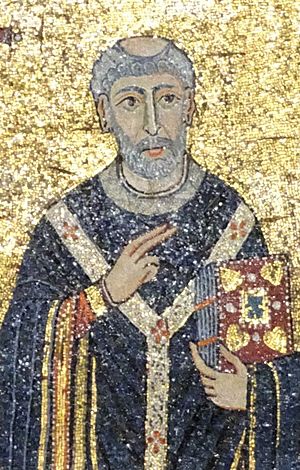Pope Callixtus I facts for kids
Quick facts for kids Pope Saint Callixtus I |
|
|---|---|
| Bishop of Rome | |

Excerpt from a mosaic in the apse of Santa Maria in Trastevere in Rome, c. 12th century
|
|
| Church | Early Church |
| Papacy began | c. 218 |
| Papacy ended | c. 222 |
| Predecessor | Zephyrinus |
| Successor | Urban I |
| Orders | |
| Ordination | 199, as deacon |
| Personal details | |
| Died | 222 Rome |
| Sainthood | |
| Feast day | 14 October |
| Patronage | Cemetery workers |
| Other Popes named Callixtus | |
Pope Callixtus I, also known as Callistus I, was an important early leader of the Christian Church. He served as the Bishop of Rome, which is like being the Pope, from about 218 AD until his death around 222 or 223 AD. He lived during the time of the Roman Emperors Elagabalus and Alexander Severus.
During his time as Bishop, Callixtus I made some big changes. He welcomed people into the Church who had previously been part of other Christian groups or who had left the Church. He was also a martyr, meaning he died for his Christian faith. Today, he is honored as a saint by the Catholic Church and is considered the patron saint of cemetery workers.
Contents
Early Life and Challenges
Callixtus I faced many difficulties early in his life. He was born in Rome and was a slave. His master, Carpophorus, put him in charge of money collected from other Christians. This money was meant to help widows and orphans.
However, Callixtus lost the funds and tried to run away. He was caught near a place called Portus. The story says he jumped into the water to escape but was rescued and brought back to his master. Later, he was released because the people he owed money to hoped he could get some of it back. He was arrested again after a disagreement in a synagogue.
Working in the Mines
According to some old writings, Callixtus was accused of being a Christian. Because of this, he was sentenced to work in the mines of Sardinia. This was a very harsh punishment.
He was eventually set free with other Christians. This happened because a man named Hyacinthus, who worked for Emperor Commodus's favorite mistress, Marcia, asked for their release. After being freed, Callixtus was very ill. Other Christians sent him to a town called Antium to get better. He even received some money from Pope Victor I to help him recover.
Becoming a Church Leader
In 199 AD, Callixtus became a deacon, which is a type of church official, under Pope Zephyrinus. Pope Zephyrinus then gave him an important job. Callixtus was put in charge of the Christian cemetery on the Appian Way.
The Catacombs of St. Callixtus
This cemetery is now known as the Catacombs of St. Callixtus. It became a very important burial place for many early Popes. It was also the first piece of land officially owned by the Church.
An ancient Roman emperor, Julian the Apostate, once wrote about Christians. He said they were popular because they were kind to strangers and took good care of burying their dead. This shows how important cemeteries were to early Christians.
In the 200s AD, nine Bishops of Rome were buried in the Catacomb of Callixtus. This special area is now called the Capella dei Papi (Chapel of the Popes). An archaeologist named Giovanni Battista de Rossi rediscovered these catacombs in 1849.
Pope Callixtus's Decisions
In 217 AD, Callixtus became the Bishop of Rome, following Pope Zephyrinus. He made some important decisions that changed the Church.
He decided to welcome people back into the Church even if they had been part of other Christian groups or had committed serious sins. He believed that all sins, even very serious ones like murder, could be forgiven through God's mercy if people truly repented.
First Antipope
Not everyone agreed with Callixtus's decisions. Another church leader named Hippolytus disagreed strongly with him, especially about forgiving sins. Because of these disagreements, Hippolytus was chosen by some people as a rival Bishop of Rome. He became the first known antipope, which means someone who claims to be Pope but is not officially recognized.
Churches and Shrines
The Basilica di Santa Maria in Trastevere was a church that Callixtus supported. There's a story that the land where he built a small prayer house was also wanted by tavern owners. But Emperor Alexander Severus decided that worshipping any god was better than having a tavern there.
A church called Ss Callixti et Iuliani was built in the 300s AD. It was later rebuilt in the 1100s and dedicated to the Blessed Virgin Mary. Another nearby church, the 8th-century Chiesa di San Callisto, is believed to be built on the spot where Callixtus was martyred. This site is mentioned in old writings from the 300s, so it's likely a historical place.
Death of Pope Callixtus I
It is thought that Callixtus I was killed around 222 or 223 AD. This may have happened during a public uprising or riot.
According to an old story, a priest named Asterius secretly buried Callixtus's body at night. Asterius was then arrested for this act and also killed.
Callixtus was buried in a cemetery called Calepodius, located on the Aurelian Way. His feast day, which is a day to remember and honor him, is celebrated on October 14th. The Catholic Church still celebrates his optional memorial on this day. In the 800s, his remains were moved to the Santa Maria in Trastevere church.
See also
 In Spanish: Calixto I para niños
In Spanish: Calixto I para niños
- List of Catholic saints
- List of popes
- Pope Saint Callixtus I, patron saint archive

